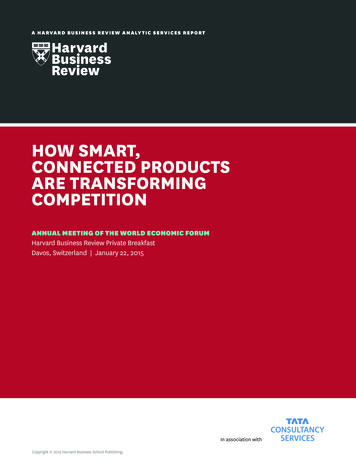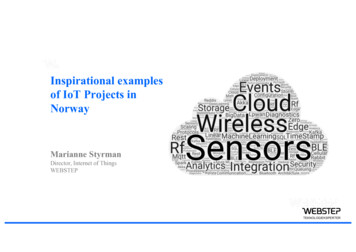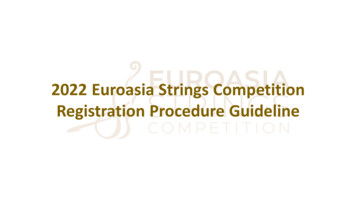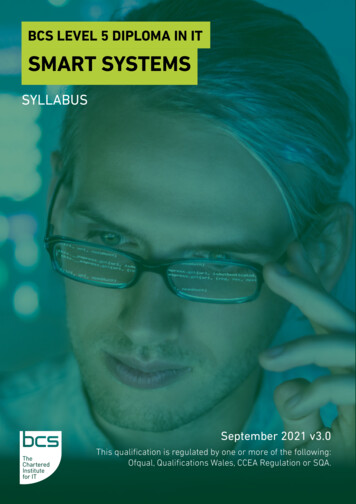
Transcription
A HARVARD BUS I N E S S R E V I E W A N A LY TI C SERVICES REPO RTHOW SMART,CONNECTED PRODUCTSARE TRANSFORMINGCOMPETITIONANNUAL MEETING OF THE WORLD ECONOMIC FORUMHarvard Business Review Private BreakfastDavos, Switzerland January 22, 2015In association withCopyright 2015 Harvard Business School Publishing.
FEATURINGMODERATED BYINTRODUCTION BYMichael PorterBishop William Lawrence UniversityProfessor, Harvard Business SchoolAdi IgnatiusEditor in Chief,Harvard Business ReviewNatarajan ChandrasekaranCEO and Managing Director,Tata Consultancy ServicesHOW SMART,CONNECTED PRODUCTSARE TRANSFORMINGCOMPETITIONAT A PRIVATE HARVARD BUSINESS REVIEW breakfast sponsored by Tata Consultancy Services, HarvardBusiness School professor Michael Porter—the world’s leading expert on competitive strategy—described how the Internet of Things is fundamentally transforming the competitive landscape.Porter drew from his recent Harvard Business Review article, “How Smart, Connected ProductsAre Transforming Competition,” to go beyond the buzz about the Internet of Things to explainhow profound technological changes are driving changes in how companies compete.Competing by merely producing physical products or using technology to automate aspects ofthe value chain will no longer be adequate. In all industries, companies will increasingly competeby producing smart, connected devices that are part of software-enabled systems or platforms.This transformation, which is already underway, is forcing companies to rethink everything theydo. This includes which capabilities are most important, what talent is most essential, what functionality is most critical to customers, how best to differentiate, which business models to pursue,and even bet-the-company questions such as “What business are we in?”KEY LEARNINGSThe Internet of Things Is Part of the Third Waveof IT-Driven CompetitionFor hundreds of years, the types of products that were produced were mechanical, andvalue-chain activities were performed manually. This has changed with successive waves ofinformation technology.WAVE 1: VALUE CHAIN AUTOMATION. In the 1960s and 1970s, IT automated previously manualprocesses of information collection and processing in individual activities across the value chain,such as order processing and billing, which improved productivity.H OW S MA RT, CO NNECT E D P RO D U CT S A R E T R A N S FO R M I N G CO M P E T I T I O N1
“During this time [waves one and two], products stayedlargely the same. The real action was in how the company didbusiness. IT was the big driver of productivity growth for acouple of decades.”MICHAEL PORTERWAVE 2: VALUE CHAIN DISPERSION AND INTEGRATION. In the 1980s and 1990s, the Internetenabled connectivity and integration across the value chain. Customer relationship managementstitched together what had been separate processes; supply chains became more global, efficient,and optimized; and again, productivity improved.WAVE 3: SMART, CONNECTED PRODUCTS. In this wave, information technology is embedded inthe products themselves, transforming value creation by triggering a new wave of transformationin the value chain. A product becomes “smart” when technology, such as a sensor, is embeddedin the product. A product becomes “connected” when one product is connected to another. Withminiaturization and ubiquitous connectivity, it is possible to make all types of products smartand connected.Smart, Connected Products Provide Entirely New Typesof Key FunctionalitiesSmart, connected products enable entirely new categories of capabilities, with each building onthe preceding layers. figure 1Capabilities of smart, connected products include:MONITORING. With monitoring there is visibility about where a product is, what it is doing, whatenvironment the product is being used in, and the condition of the product. By monitoring aproduct it is possible to set acceptable ranges and trigger alerts and alarms.CONTROL. In addition to monitoring a product, it may be possible to embed software that enablesbidirectional control over a product, controlling the product from a phone or tablet.OPTIMIZATION. If a product can be monitored and controlled, it is possible to add algorithms tooptimize its operation and performance. This can include predictive maintenance to intervenebefore something bad happens.AUTONOMY. Ultimately it will be possible to create products that act on their own.2H A RVA R D BU S I N E S S R E VI E W A N A LYT I C S E RVI C E S
FIGURE 1CAPABILITIES OF SMART, CONNECTED cting Smart Products Requires a New Typeof “Technology Stack”The connection of smart products requires a new type of technology platform or “stack.” Thetechnology stack will enable a product to connect with other products (via a wire, wireless, WiFi,Bluetooth, or cellular). It requires building a cloud to which the product will connect and creatinga big data database to aggregate data from multiple products as well as from internal businesssystems and external sources. Analytics are needed to analyze and derive value from the massiveamounts of data. There will need to be an application platform and various business applications.All of these technologies need to be connected in a secure way, which makes cybersecurity critically important and exponentially more complex. All of these elements of the technology stackneed to be addressed before a product is developed and launched.Smart, Connected Products Have Significant Implicationsfor Corporate StrategyUnlike the previous waves of IT transformation that boosted firm productivity, this wave will affectcompanies’ strategies and how companies differentiate themselves, create value, and compete,and will change the structure of industries. Smart, connected products will blur the boundarieswithin an industry and will shift bargaining power.These products will change the basic principles of product design. Products will be designed to bepart of systems and have “evergreen” design so they can be continuously services and upgraded,with product usage data enabling rapid redesign. They will be customized and designed for security.Take the farm equipment industry, for example, which illustrates how smart, connected products are changing boundaries, industries, and competition. figure 2 Previously, a company made aproduct—a tractor. The product evolved to become a smart product, and then a connected product, which made it an even better tractor. Suppliers in this industry competed based on whichcompany had the best smart, connected tractor.H OW S MA RT, CO NNECT E D P RO D U CT S A R E T R A N S FO R M I N G CO M P E T I T I O N3
“What used to be a single product is now a family of connectedproducts or a whole system of families of connected products.That raises a lot of strategy questions.”MICHAEL PORTERFIGURE 2EXPANDING INDUSTRY BOUNDARIES—FARM EQUIPMENT EXAMPLEPRODUCTSMART PRODUCT SMART, CONNECTEDPRODUCTPRODUCT SYSTEMS SMART, CONNECTEDPRODUCT cedatabaseseeddatabaseSOURCE PLEASE PROVIDE. NOT READABLE IN SOURCE orecastsweatherdataapplicationH A RVA R D BU S I N E S S R E VI E W A N A LYT I C S E RVI C E S
The real transformation is when smart, connected products are brought together into a connected“product system” where the smart, connected tractor is integrated with other farm equipment tooptimize the entire farming operation. And, one farm equipment system can be connected withother systems, creating a system of systems. This represents a fundamental change in a company’sbusiness model from making and selling a product to making entire product systems or platforms.The possibilities now available require that companies answer major strategic questions such aswhat business they are in. Companies have to decide if they want to be the system integrator thatprovides the entire platform or one discrete product on a larger platform.The Emergence of the Internet of Things Will Force Companiesto Make Hard Strategic ChoicesThis wave of information technology is complicated and is forcing companies to make difficultdecisions. To assist leaders in thinking through these choices, Porter has created a frameworkwith 10 strategic questions. figure 3These important choices include which capabilities to pursue and what functionality to embed,whether to create an open or a proprietary system, what type of data to capture and how to manageit, what business model to pursue, the scope of the offering, and more.FIGURE 3TEN STRATEGIC CHOICES12345678910Which capabilities to pursue?Functionality: Embedded in the product vs. in the cloud?Open or closed system?Technology development: Internal or external?What data to capture?How to manage data rights and access?Disintermediate distribution or service channels?Change the business model?Sell data to outside parties?Expand product scope?H OW S MA RT, CO NNECT E D P RO D U CT S A R E T R A N S FO R M I N G CO M P E T I T I O N5
“There are big bets that companies have to make in a worldof smart, connected products that are going to be profoundlyimportant to the success of the company, which are things wenever had to think about before, not in the same way.”MICHAEL PORTERThe Internet of Things Will Produce Distinct Winnersand LosersThere will be many winners and losers. Winners will have to make the right choices and get thebasics right. Among the key characteristics of winners will be:ASSEMBLING THE RIGHT EXPERTISE AND TALENT. Companies will need different types of talentthan in the past, which will include software engineers and data scientists.RETHINKING PRODUCT DEVELOPMENT. The process of developing new products must be handleddifferently from when the products being developed were merely physical, mechanical products.PICKING FUNCTIONALITY THAT CUSTOMERS VALUE. Technology makes an amazing array of func-tionality possible. But winners will focus on functionality that provides value that customers arewilling to pay for.Ultimately, the biggest factor that will distinguish winners and losers is the choice of what business a company is in.The emergence of smart, connected products with embedded technologies is likely to drive consolidation among companies with complementary product portfolios, also resulting in new playerswith new products and models.For existing companies, it is important not to view this new technological wave as incremental innature. These technologies are transformational, with major implications for companies’ strategies, for how companies compete, and for which companies will win and lose.6H A RVA R D BU S I N E S S R E VI E W A N A LYT I C S E RVI C E S
PARTICIPANT BIOGRAPHIESMICHAEL E. PORTERBISHOP WILLIAM LAWRENCE UNIVERSITY PROFESSORHARVARD BUSINESS SCHOOLMichael E. Porter is a leading authority on competitive strategy; the competitiveness andeconomic development of nations, states, and regions; and the application of competitiveprinciples and strategic approaches to social needs such as health care, innovation, andcorporate responsibility. Porter is generally recognized as the father of the modern strategyfield, and has been identified in rankings and surveys as the world’s most influential thinkeron management and competitiveness. As the Bishop William Lawrence University Professorbased at Harvard Business School, Porter has received the highest professional recognitionthat can be awarded to a Harvard faculty member.ADI IGNATIUSEDITOR IN CHIEF HARVARD BUSINESS REVIEWAdi Ignatius joined HBR as editor in chief in January 2009. Previously, he was deputy managing editor for TIME. He was the editor of two New York Times best-selling books: PresidentObama: The Path to the White House and Prisoner of the State: The Secret Diaries of PremierZhao Ziyang. Prior to his 2007 appointment as deputy managing editor, Ignatius served asexecutive editor of TIME starting in 2002, and from 2004 to 2007 he also held the additionaltitle of editor of TIME Canada. Ignatius joined TIME as deputy editor of TIME Asia in 1996 andwas named editor of that edition in 2000. He also wrote frequently for TIME, including coverstories on Google Inc. and the 2007 Person of the Year profile of Vladimir Putin. Prior to joiningTIME, Ignatius worked for many years at the Wall Street Journal, where his work was nominated for a Pulitzer Prize.Ignatius was awarded a Zuckerman Fellowship at Columbia University’s School of Internationaland Public Affairs in 1990. He received his BA in history in 1981 from Haverford College. He isa member of the Council on Foreign Relations and the Asia Society.NATARAJAN CHANDRASEKARANCEO AND MANAGING DIRECTOR TATA CONSULTANCY SERVICESNatarajan Chandrasekaran (“Chandra”) is the CEO and managing director of Tata ConsultancyServices (TCS), the company recognized as the industry leader in customer satisfaction and thefastest-growing brand in the IT services industry. TCS’ global talent base of 318,000 consultantsis helping corporations across the world simplify, strengthen, and transform their businesses.During Chandra’s tenure as the chief executive since October 2009, the company has grownat a compounded annual rate of 21 percent. Responsible for formulating the company’s globalstrategy across its footprint of 46 countries, Chandra led TCS to a market capitalization of overUS 80 billion during 2014. He is the serving chairperson of the IT governors steering committeeat the World Economic Forum and is considered the leading voice in the industry on the transformational power of technology. Beyond the office, Chandra is a passionate long-distance runnerand has completed marathons in New York, Prague, Stockholm, Vienna, Chicago, and Berlin.H OW S MA RT, CO NNECT E D P RO D U CT S A R E T R A N S FO R M I N G CO M P E T I T I O N7
PERSPECTIVE FROM TATA CONSULTANCY SERVICESTHIS DISCUSSION ON the future impact of smart, connected products is extremely timely. 2015 isgoing to be a defining year for the Internet of Things (IoT), which is poised to transform every company,industry, and society. The world economy is in the midst of a shift from the Internet economy to whatcan be called the Digital Consumer Economy. This shift will reshape the competitive landscape ofvirtually every company. The emerging digital consumer economy is characterized by empowermentof consumers with pervasive digital devices, which are embedded with sensors. These devicesprovide anytime, anywhere access to contextual real-time information that customers need in orderto make decisions. These consumers are connected with one another via social networks and shareintelligence. Equally, the companies that serve consumers are also empowered with informationabout these consumers, completing the information food chain. The rapid declines in the costs ofprocessing power and sensors over the past 10 years is further fueling this transformation and makingit even more affordable.The five key technologies that we call the Digital Five Forces are also maturing and further precipitatingthe shift to the Digital Consumer Economy. These are Mobility and Pervasive Computing, Big Data,Social Media, Cloud, and AI-Robotics. These forces are increasingly being used in various permutationsand combinations to drive new applications. As a result, new Digital Composite Forces are emerging.Foremost among them is the Internet of Things, which combines mobility and pervasive computing,big data, cloud, and—increasingly—artificial intelligence. A potential 50 billion devices are likely tobe connected to the IoT in the next five years (by 2020), driving new economic opportunities.A vast majority of business leaders are still unsure about what to do about this oncoming change, butit is crucial that they start embarking on the road to what we have termed “Digital Reimagination.”This involves leveraging a combination of the Digital Five Forces and Digital Composite Forces toreimagine the enterprise along one or more of six dimensions: business models, products and services,customer segments, channels, business processes, and workplaces. Though the fundamental rulesof competition and strategy do not change, the competing players undergo significant change interms of how they operate with or relate to their own customers. Recently, we leveraged the IoTfor a major global engine manufacturer to create a new services stream by using sensor-collectedbig data to predict failures on their engines. When such a failure is predicted, the vehicle operatorsare automatically sent notifications along with directions to the nearest service center. Apart fromdriving new maintenance revenue, this has also helped improve the customer experience by reducinginconvenient breakdowns.The opportunities for businesses are limitless, as are the growing risks and need for cybersecurityfor the new IoT networks being built. This is why we agreed at Davos that the primary priorities forthe IT industry in 2015 will be twofold: First, building up a strong Internet of Things that improves thestate of the world, and second, securing this through enhanced cybersecurity and global Internetgovernance. Most of all, we need to change competitive strategies, cultures, and mindsets to embracethis new world—one in which the default is digital.Natarajan ChandrasekaranCEO AND MANAGING DIRECTOR TATA CONSULTANCY SERVICES
hbr.org/hbr-analytic-services
HOW SMART, CONNECTED PRODUCTS ARE TRANSFORMING COMPETITION 5 The real transformation is when smart, connected products are brought together into a connected "product system" where the smart, connected tractor is integrated with other farm equipment to optimize the entire farming operation. And, one farm equipment system can be connected with










